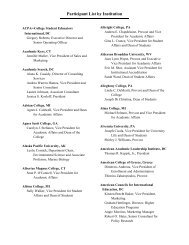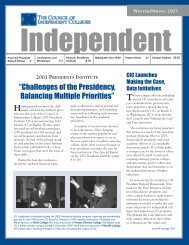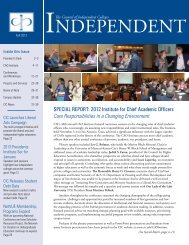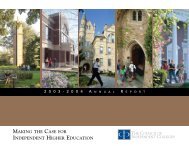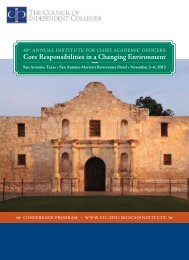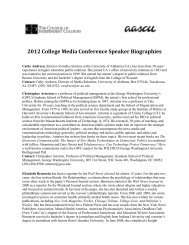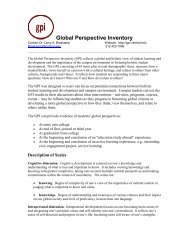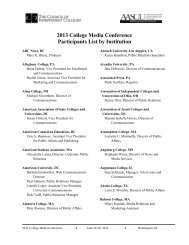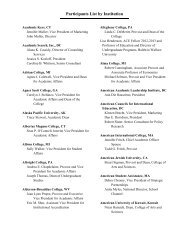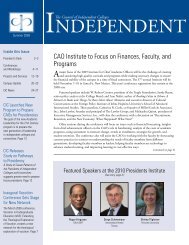Summer 2001 - The Council of Independent Colleges
Summer 2001 - The Council of Independent Colleges
Summer 2001 - The Council of Independent Colleges
You also want an ePaper? Increase the reach of your titles
YUMPU automatically turns print PDFs into web optimized ePapers that Google loves.
BOARD OF DIRECTORS<br />
EXECUTIVE COMMITTEE<br />
Chair: Margaret A. McKenna,<br />
Lesley University<br />
Richard Detweiler, Hartwick College<br />
Catherine Dunn, BVM, Clarke College<br />
John L. Henderson, Wilberforce University<br />
Richard W. Kimball, <strong>The</strong> Teagle<br />
Foundation, Inc.<br />
Richard Kneedler, Franklin and<br />
Marshall College<br />
Douglas M. Orr, Jr., Warren Wilson College<br />
Richard Ekman, <strong>Council</strong> <strong>of</strong> <strong>Independent</strong><br />
<strong>Colleges</strong> (Ex Officio)<br />
DIRECTORS<br />
Loren Anderson, Pacific Lutheran University<br />
Delbert W. Baker, Oakwood College<br />
Dorothy G. Blaney, Cedar Crest College<br />
Doreen E. Boyce, <strong>The</strong> Buhl Foundation<br />
John F. Budd, Jr., <strong>The</strong> Omega Group<br />
R. Judson Carlberg, Gordon College<br />
Richard J. Cook, Allegheny College<br />
William H. Crouch, Georgetown College<br />
Richard Dalrymple, Teamwork<br />
Management, Inc.<br />
Thomas F. Flynn, Millikin University<br />
Robert M. Frehse, Jr., <strong>The</strong> William<br />
Randolph Hearst Foundations<br />
George H. Johnson, LeMoyne-Owen<br />
College<br />
James N. Loughran, SJ, Saint Peter’s College<br />
Audrey Manley, Spelman College<br />
Shirley M. McBay, Quality Education for<br />
Minorities Network<br />
Scott D. Miller, Wesley College<br />
John Morning, John Morning Design, Inc.<br />
Frederick V. Moore, Buena Vista University<br />
Anita Pampusch, <strong>The</strong> Bush Foundation<br />
Jerold Panas, Jerold Panas, Linzy<br />
& Partners<br />
Larry D. Shinn, Berea College<br />
Shirley H. Showalter, Goshen College<br />
Jake B. Schrum, Southwestern University<br />
Nancy A. Wilgenbusch,<br />
Marylhurst University<br />
HONORARY DIRECTORS<br />
Arthur C. Frantzreb,<br />
Consultant in Philanthropy<br />
William H. Gray, III,<br />
<strong>The</strong> College Fund/UNCF<br />
Charles A. Johnson,<br />
Lilly Endowment, Inc. (retired)<br />
J. Richard Munro, ATC Corporation<br />
Richard White, Bayer Corporation<br />
DIRECTORS EMERITI<br />
<strong>The</strong>odore Q. Demeritte,<br />
Demeritte & Associates, Inc.<br />
K. Duane Hurley, Salem<br />
International University<br />
John Mason, Monsanto Fund (retired)<br />
Joel D. Weiner, Kraft (retired)<br />
Patricia L. Willis, BellSouth Corporation<br />
<strong>The</strong> good news is that high school<br />
seniors, their parents, journalists,<br />
and state legislators increasingly seek<br />
indicators <strong>of</strong> quality in higher education.<br />
A college with distinction in one<br />
or more programs or in the track record<br />
<strong>of</strong> alumni has a more attentive audience<br />
now than a generation ago. In combination<br />
with such familiar factors as a college’s<br />
location or price, soaring numbers<br />
<strong>of</strong> applications to<br />
some colleges and<br />
universities and<br />
precipitously<br />
falling numbers to<br />
others suggest a<br />
degree <strong>of</strong> discrimination<br />
by prospective<br />
students not<br />
seen earlier in this<br />
century.<br />
<strong>The</strong> bad news<br />
is that the public’s measures <strong>of</strong> educational<br />
quality are not always the ones<br />
that we who are in the field believe are<br />
accurate. <strong>The</strong> disproportionate influence<br />
<strong>of</strong> the U.S. News & World Report rankings<br />
is symptomatic. But meanwhile,<br />
more fundamental aspects <strong>of</strong> educational<br />
quality are not being addressed adequately—such<br />
as how much students<br />
learn and how well they use their<br />
knowledge.<br />
To fill the vacuum, in the world <strong>of</strong><br />
small colleges we have seized upon the<br />
National Survey <strong>of</strong> Student Engagement<br />
(NSSE) (a survey conducted for the first<br />
time last year, funded by the Pew<br />
Charitable Trusts) because it suggests<br />
that students are more deeply involved<br />
in their education at small, private institutions.<br />
<strong>The</strong> NSSE was not intended to<br />
be a measure <strong>of</strong> institutional quality, but<br />
it is being used in that way, given the<br />
paucity <strong>of</strong> other measures. And surveys—by<br />
the Lutheran colleges, for<br />
FROM THE PRESIDENT’S DESK<br />
Judging Educational Quality—<br />
Let’s Take a Longer Term View<br />
“Fundamental aspects<br />
<strong>of</strong> educational quality are not<br />
being addressed adequately—<br />
such as how much students<br />
learn and how well they use<br />
their knowledge.”<br />
By Richard Ekman<br />
example—that illustrate the greater<br />
civic and moral commitment <strong>of</strong> graduates<br />
<strong>of</strong> church-related colleges have<br />
become handy measures <strong>of</strong> quality. We<br />
also look at the record <strong>of</strong> small colleges<br />
in producing career scientists—in disproportionate<br />
numbers. Accreditors who<br />
have in the past looked at student-faculty<br />
ratios and the numbers <strong>of</strong> books in<br />
libraries—simple, if insufficient, indicators<br />
<strong>of</strong> quality—<br />
need to expand<br />
upon these<br />
measures.<br />
More emphasis<br />
on student<br />
learning outcomes<br />
would be<br />
useful, especially<br />
when tied to<br />
issues that<br />
already have the<br />
public’s attention. <strong>The</strong> “new” Knight<br />
Commission, for example, has suggested<br />
a link between athletes’ academic performance<br />
and continued eligibility to<br />
compete that could be incorporated into<br />
regional accrediting standards. To be<br />
sure, every specialized accrediting<br />
agency thinks its concerns should be<br />
given more prominence in general<br />
accreditation <strong>of</strong> institutions, but that in<br />
itself is not a reason to refrain from<br />
adopting some <strong>of</strong> them. Accreditors<br />
have an obligation to choose those that<br />
are most important.<br />
More use <strong>of</strong> longitudinal data could<br />
also illuminate the connection between<br />
the in-school experience and the longterm<br />
returns from higher education.<br />
William G. Bowen and Derek Bok’s<br />
<strong>The</strong> Shape <strong>of</strong> the River: Long-Term<br />
Consequences <strong>of</strong> Considering Race in<br />
College and University Admissions is a<br />
(cont’d on page 7)<br />
<strong>Independent</strong> 2 www.cic.edu<br />
<strong>Summer</strong> <strong>2001</strong>



